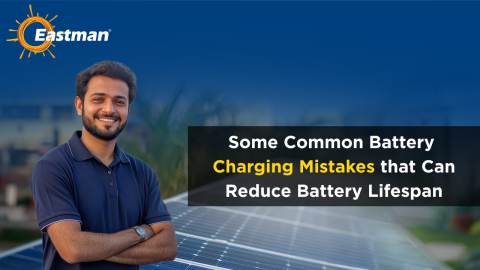
Everything to Know about Tubular Batteries
I. Introduction
Tubular batteries, unlike their conventional counterparts, boast a distinctive cylindrical design housing a myriad of components. Picture a series of interconnected tubes within, each playing a crucial role in storing and discharging energy. These batteries are crafted with precision, using a combination of lead-acid and advanced technology. This helps to create a robust and efficient power source.
Now, why should the power industry take note of these cylindrical powerhouses? Simply put, they are the backbone of an uninterrupted power supply. Their ability to store energy for numerous charge-discharge cycles makes them a cornerstone in various applications. Read this comprehensive guide to grasp the intricacies and perks of these robust powerhouses.
II. Detailed Description of the Design and Components
Tubular batteries, true to their name, boast a cylindrical design. They often resemble a cluster of mini tubes aligned within a larger casing. These tubes are where the science happens!
Here is a breakdown of their components:
Positive Plates: These plates are the powerhouses where lead oxide reacts with sulfuric acid during charging and discharging, facilitating the flow of electrons.
Negative Plates: Comprising sponge lead, these plates are the counterbalance to the positive plates. It enables the electrochemical reactions needed for energy storage and release
Separator: Think of this as the referee between the positive and negative plates. The separator prevents short-circuiting while allowing the flow of ions, which is crucial for the battery’s functionality.
Electrolyte: Sulfuric acid serves as the electrolyte. This mainly aids in the transfer of ions between the positive and negative plates.
Tubular Structure: This unique arrangement of components in a tubular format maximizes surface area contact, optimizing the battery’s efficiency and energy output.
III. Working Principle
At the heart of every tubular battery, electrons, and chemicals create energy. Let’s take a peek behind the scenes:
Electrochemical Process:Tubular batteries operate on a fundamental principle of electrochemical reactions. Within the confines of those tubular structures, a concoction of lead oxide and lead is immersed in a sulfuric acid electrolyte. As the battery discharges, lead sulfate and water are formed, releasing electrons and generating electrical energy.
The Charge Cycle:During charging, this process reverses. External electrical energy is applied, coaxing the lead sulfate back into its original form of lead oxide and lead while converting electrical energy into chemical potential. This charging process is akin to refilling the reservoir and preparing the battery for the next round of empowering your devices.
Now, imagine you have unplugged that charged battery. The lead oxide and lead, enriched with electrical potential, start a transformative journey. The chemical reactions release stored energy, pushing electrons through the circuit. This powers your gadgets or backup systems. It’s like unlocking the floodgates of energy, releasing the stored power in a controlled and efficient manner.
How the Structure Affects Performance
The tubular design isn’t just for aesthetic appeal; it profoundly impacts the battery’s performance:
Enhanced Efficiency: The cylindrical configuration allows for a more efficient distribution of active materials, ensuring better contact between electrodes and electrolytes. This, in turn, enhances the battery’s efficiency and overall output.
Improved Durability: The robust tubular structure inherently offers greater resilience against internal stresses, reducing the risk of deformation and enhancing the battery’s lifespan.
IV. Advantages of Tubular Batteries
1. Enhanced Durability and Lifespan
Tubular batteries aren’t just built; they’re crafted for resilience. The secret lies in their robust construction, where each component plays a role in defying the test of time. The tubular design not only provides structural integrity but also acts as a shield against the wear and tear that conventional batteries may succumb to over time. This enhanced durability translates into a prolonged lifespan, offering a reliable and long-lasting power solution for your diverse energy needs.
2. Superior Performance in Different Conditions
Tubular batteries are the chameleons of the energy landscape, adapting seamlessly to diverse environmental conditions. The design and composition of tubular batteries make them less susceptible to temperature variations. No more worrying about power failures during extreme weather events. Tubular batteries shine bright when conventional batteries might falter, making them the go-to choice for those who demand reliability in every season.
3. Low Maintenance and Efficiency
Who has the time to constantly babysit their batteries? Tubular batteries understand the value of your time and energy, offering a low-maintenance solution without compromising efficiency. The unique design minimizes the need for frequent check-ups. With the right care, they can go the distance without demanding much in return.
Types of Tubular batteries
1 – Short tubular battery
Short tubular batteries are smaller and more compact. This makes them suitable for areas with limited space. They have a smaller capacity and offer lower backup times as compared to tall tubular batteries.
2 – Tall tubular battery
Tall tubular batteries are larger and occupy more space due to increased height. The larger size of tall tubular batteries allows for more electrolyte volume and increased active material, resulting in higher power backup.
V. Maintenance and Care Tips
A. Guidelines for Optimal Performance and Longevity
Keep it Clean: Maintain cleanliness around the battery area. Dust and grime accumulation can interfere with performance. Wipe the surface gently and ensure it stays dry to prevent any moisture-related issues.
Temperature Control: Extreme temperatures can affect battery life. Try to keep your tubular battery in a moderate-temperature environment to extend its lifespan.
Proper Ventilation: Ensure the area around the battery has adequate ventilation. Proper airflow helps in dissipating heat, preventing overheating issues.
B. Dos and Don’ts for Maintaining Tubular Batteries
Dos:
Follow Charging Instructions: Charge your tubular battery as recommended by the manufacturer. Avoid overcharging, which can lead to excessive heat and damage the battery.
Watering at the Right Time: If your tubular battery requires maintenance (topping up with distilled water), do it only after charging and when the battery is cool. This prevents spillage and ensures proper electrolyte levels.
Don’ts:
Do not Over-discharge: Avoid completely draining your tubular battery. Continuous deep discharges can harm the battery’s capacity and lifespan.
Avoid Mixing Battery Types: Stick to using similar types and brands of batteries in a system. Mixing different types or ages can lead to imbalances and affect performance.
Avoid Using Tap Water:When topping up electrolytes, never use tap water. It contains minerals that can harm the battery. Stick to distilled water for maintenance.
VI. How to Choose the Right Tubular Battery
A. Factors to Consider While Purchasing
- Intended Use: Define the purpose. Are you aiming for backup power at home, industrial applications, or renewable energy systems? Different uses might require specific features.
- Quality and Brand: Trustworthy brands often offer reliability and better performance. Research and reviews can guide you toward reputable manufacturers known for their quality tubular batteries.
- Cycle Life: You can Assess the number of charge-discharge cycles the battery can endure over its lifetime. A longer cycle life often indicates durability and cost-effectiveness.
B. Sizing, Compatibility, and Capacity
- Sizing for Application: You need to calculate the power requirements of your application. The size of the battery should align with the energy demands to ensure sufficient power supply.
- Compatibility with Charging Systems: You can ensure the compatibility of the tubular battery with your existing charging systems. Some batteries might require specific chargers or inverters.
- Capacity vs. Discharge Rate: You should understand the battery’s capacity in relation to its discharge rate. A higher discharge rate might impact the overall capacity available for your application.
In conclusion
Whether you are powering a remote appliance or ensuring uninterrupted electricity for your home, these batteries have your back. They deliver power-packed performance with a touch of elegance. Moreover, in an era inclined towards sustainable energy solutions, tubular batteries complement the drive towards eco-friendliness. Their efficient storage and utilization of energy from renewable sources contribute to a cleaner and greener energy ecosystem. So, choose wisely and power responsibly!
Recent Blogs

How Eastman Solar Battery Backup is Suitable for Residential & Commercial
With rising electricity demands, frequent grid fluctuations, and the growing shift toward renewable energy, solar battery backup
Read More
Why BMS is Critical for Solar Lithium Batteries
As solar energy adoption accelerates across residential, commercial, and industrial sectors, lithium batteries have quickly becom
Read More
How Solar Batteries Work at Night: The Complete Process
Ever wondered what happens to your solar power after sunset? Your panels are asleep, the sky is dark, yet your home still runs smoothly: fans spinning
Read More
Some Common Battery Charging Mistakes that can Reduce Battery Lifespan
In today’s power-driven world, whether you rely on solar batteries, inverter batteries, lead-acid batteries, or lithium-ion batteries, maximizing
Read More
Why Eastman Solar Combo Kits Are the Perfect All-in-One Solution
In an era where sustainable living is not just a choice but a necessity, embracing solar energy stands out as a powerful step forward.
Read More
